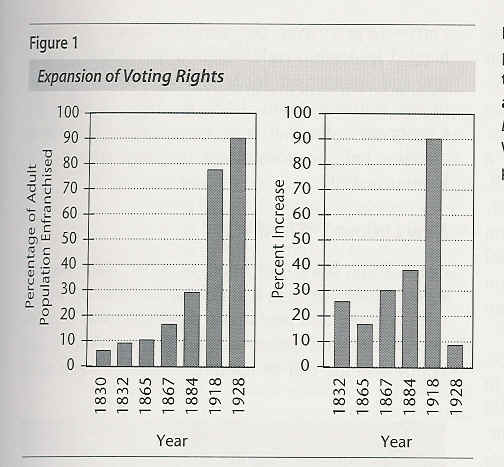
PLS 131 - British Politics
I. Basic themes found in discussions of British politics
a. Gradualism - lack of revolutionary break
b. Combination of traditional and modern features
c. Geographic separation from Europe
II. Identity crisis overcome
a. Since Battle of Hastings, 1066, territorial aspect of Britain takes shape
1. Based in England, but incorporates Wales in 15/16th centuries
2. Incorporates Scotland (unified under Act of Union, 1707
3. Ireland - subject to colonial domination, gains independence after war with GB (1919-1921)
a.
Leads to inconclusive partitioning of Ireland into "Irish Free State"
and "North Ireland" a
contested province of Great Britain
b. Maintains basis for religious strife in North Ireland
4. But otherwise, ascendancy of Anglican Church as official church limits
religious strife within
GB itself
a. No religious parties
b. No strong correlation between religiosity and voting patterns
III. Legitimacy Crisis mitigated through gradualism and expanding participation
a. Constant theme - tension between executive and legislative "branches" of government
1. Magna Carta - obliges King to recognize rights of feudal aristocracy
2. Early tradition of "parliaments" since 1236 - a body to be convened to provide consent to King for taxes and military adventures
3. 1400s - Parliament able to make general laws
4. Glorious Revolution
- (1688) again confirmed role of Parliament with abdication of James II
and
installation of William and Mary, set basis for "constitutional monarchy" and
end of Catholic
governing presence
a. Parliament has annual meetings and regular elections (only of aristocrats at early stages).
5. Overall tradition of Parliamentary ascendancy over Monarchy is clear
a. Declining importance of Monarchy - with rise of modern party system in 20th
century, slips into
purely "dignified" and symbolic role
b. Matched by erosion of role of House of Lords (Parliament act of 1911),
rise of House of
Commons
1. Prime Minister eventually becomes chief executive - responsible to
Parliament and selected
by Parliament not King
IV. Participation Crisis - eroded by gradualism
a. Legitimacy of representative institutions signaled by expansion of franchise
1. Expansion of franchise
a. Parliamentary Reform Act of 1832 increased the franchise in Britain from
435,000 to
653,000 includes more rising capitalist class
b. Chartist movement attempts to stimulate more rapid expansion to working class
during late 1830s
but without
immediate success
c. Reform Act of 1867 more than doubled the franchise from 1,120,000 to
2,500,000 - men in
towns and cities only
(+propertied interests)
d. Third Reform Act of 1884-1885 extended the franchise from 2.5 million to 5
million by giving the
vote to working class men from rural areas (29% of pop)
e. Representation of the People Act (1918) extended franchise to most women (74% of pop)
f. Equal Franchise Act (1928) - extended franchise to all men and women at least
21 years old
(97%)

V. Penetration Crisis - State building and economic development
a. Industrialization
1. accelerates in mid-1700s
a. social effects
1. large displacement of population from agriculture, rural areas to industrial
urban centers - creates
industrial working class
2. Erodes power of feudal aristocracy, many of whom adopt ways of capitalism and
turn into a
semi-modern "bourgeoisie"
2. Based on British imperialism - Britain as the "hegemonic power"
a. Cotton manufacture used imported raw materials, thrived on overseas markets
b. 18th century British military/naval superiority helped establish concept of
"free trade" and liberal
economic principles -
state is outward oriented
c. By mid-18th century, empire and industry had combined to make GB the
preeminent power, both
politically and
economically
|
British Proportion of World Trade and Relative Labor Productivity |
||
| 1870 | 24 | 1.63 |
| 1890 | 19 | 1.45 |
| 1913 | 14 | 1.15 |
| 1938 | 14 | .92 |
b. The state and the economy
1. Wars increased state control over the economy, set up basis for divergence from pure "free market"
2.
State develops relationship with industrial working class, trade unions - first
of antagonism, then of
accommodation
a. Interwar period - industrial strife, strongly ideological challenges to British capitalism
b. Postwar period - 1940s to 1970s - "collectivism" consensus
paradigm for Conservative and
Labour (note spelling) parties
Main elements of collectivism: limited nationalization, expanded welfare programs, Keynesian fiscal policy, neo-corporatism.
1. Limited nationalization of some industries
2. State responsibility for social welfare
a. free schools
b. free health care
c. subsidized housing
d. Social security
3. Keynesian economics - meant to provide full employment, but required
labor peace and
high taxes
4.
Neo-corporatism - a process meant to reduce industrial strife - voluntary
inclusion of major
producer interest groups within economic decision-making process
(trade unions, business
associations) - negotiated restraints on prices and wages sought
a. Compare with France - GB without state planning coordination on
industry-by-industry basis
b. Mostly focused on Keynesian counter-cyclical interventions (fiscal and
monetary)
by Treasury/Bank of England
5. Model declines during 1970s
a. Economic stagnation, declining competitiveness of British
economy -
1. spurs renewed industrial strife, "winter of discontent," fall of Labour Party
c. Thatcherism
- neo-conservative reversal of collectivism (1979-1997) -
(includes both
Margaret Thatcher as PM 1979-1990 and John Major - 1990-1997)
Main elements: free market, ends neo-corporatism, restrictions on unions, denationalization, erosion of welfare programs
1. State breaks corporatist ties with unions, business - return to purer
market principles, uses "monetarism" -
even more passive role for State, focus on providing good business climate
a. secret ballots for strikes
b. Limits on picketing
2. Lowered taxes
3. Denationalization
a. Dramatic increase in stock ownership
4. Diminution of welfare state
a. E.g., sale of public housing to residents, privatization of some services, workfare, reduced colas

d. Erosion of Conservative successes in 1990s
1. high unemployment, rise in saliency of social problems, welfare policies
a. Many problems remained or got worse regarding inequality, the economic
situation of
immigrants and women
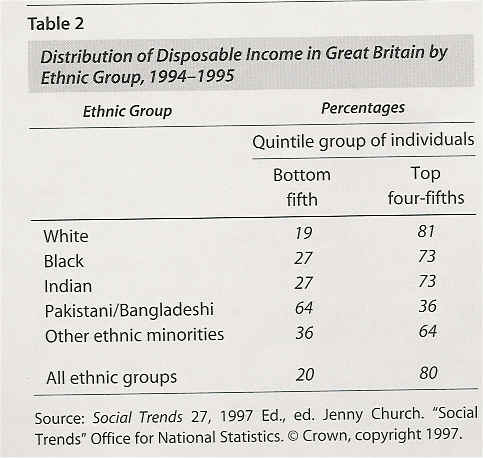
2. Mad cow disease
3. North Ireland bombings
4. Various political scandals
5. Intra-Conservative Party divisions on European Monetary Union
a. Thatcher resists joining ERM until 1990 (to control inflation);
Major sought
middle road - Yes to Maastricht Treaty but not European Monetary Union
and Social Charter
e. Rise of the "Third Way" - Tony Blair returns Labour Party to power, but with what agenda?
1. Unions a diminished presence within Labor Party
2. Blair rejects any return to "neo-corporatism" - accepts need for
labor market flexibility -
but combined with more attention to inequality
3. Promises to retain most of the Thatcher economy - lower taxes, reliance on
business initiative,
worker training and
education spending, restrictions on welfare eligibility, more privatization,
rejection of Labour' ideological socialism...
a. Will Labour govt. return to counter cyclical measures
or focus mostly on business incentives
b. Modernization of economy: govt.-business "partnerships" for
R&D, training, technology
c. Stakeholder economy - workers have skills/training to compete, business has
proper
climate for investment
4. Promises referendum on EMU- but "Third Way" accepts
globalization and EU integration as
one of its elements...
5. Promises devolution of power to local assemblies in Scotland, Wales and Northern Ireland
Cameronism: The Conservative-Liberal Coalition's return to Thatcherism?
1. 2010 Election results in a split Parliament - Conservatives (led by David Cameron) need to form a coalition with Liberal Party led by Nick Clegg
2. Main focus: reduce government deficit
a. cut departmental spending
b. reduce college subsidies
c. raise some taxes
d. regulatory reform of finance/banking
3. Will this be sustainable? Can destimulating fiscal policies reduce role of govt. without undermining stability?
VI. British Political Institutions - Constitution, Monarchy, Parliament, Prime Minister, Cabinet, Party System
A. British constitution
1. "Unwritten" - combination of statutory laws, common law, conventions and authoritative interpretations
2. Constitutional Monarchy - hereditary but without powers...symbolic unity of country
3. Parliamentary sovereignty - no checks upon Parliament by other branches
4. Parliamentary democracy - executive (Prime Minister) accountable to the legislature
a. fusion of powers between executive, legislature

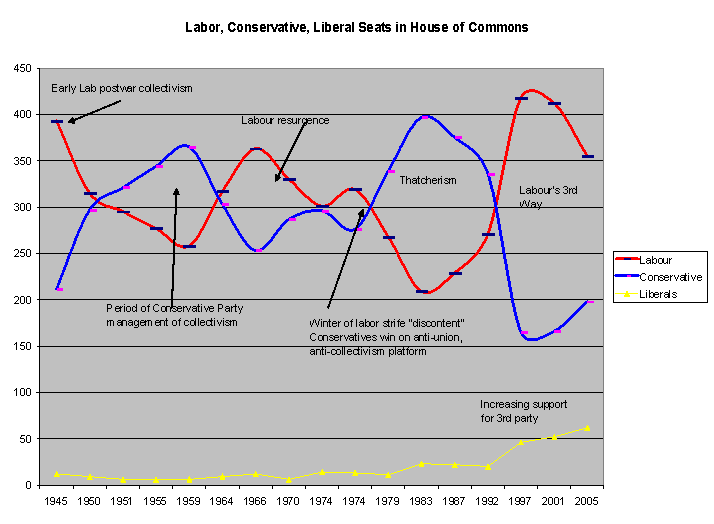
B. British Party System - a "mostly" two party system
1. Two major parties
a. Labour - derived from union and ideological socialist origins,
with working class electorate -
now
"moderate" somewhat left party with broader appeal
b. Conservative - secular conservatives with
aristocratic heritage -
1. had a "progressive" tradition of paternalistic preemptive social
policies that took some of the
wind out of Labour radicalism
2. Paternalism conflicts with traditions of individualism and enterprise
3. Post-Thatcher vision less clear due to lingering divisions over GB and EU,
social and economic
policies
2. Other parties
a. Liberal party - vague ideology mostly situated in centrist
"gaps" between Labour and Conservatives
b. Scottish
Nationalist Party - pursued Scottish autonomy from England, mostly due to
North Sea oil
discoveries...but very small vote esp. outside Scotland
c. Green
Party - formed in 1973, but generally with small electoral impact
d. Far
Right parties - National Front and British National Party - anti-immigrant
parties with small
electoral base
3. Electoral system
a. "single member plurality system (winner take all) - reinforces success of larger parties
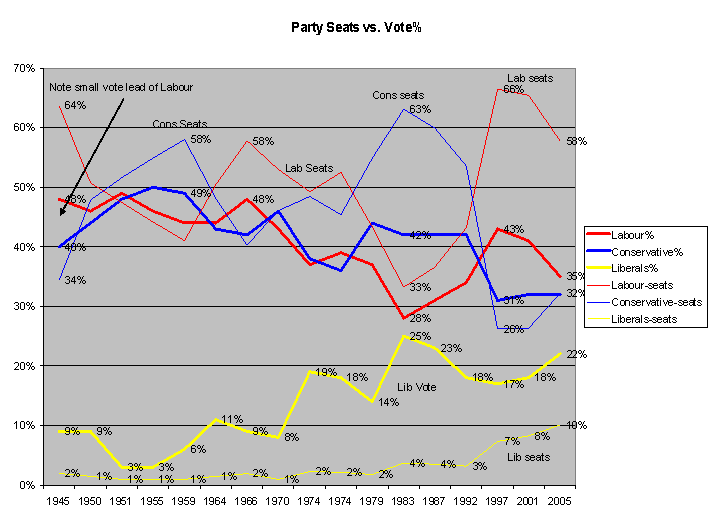
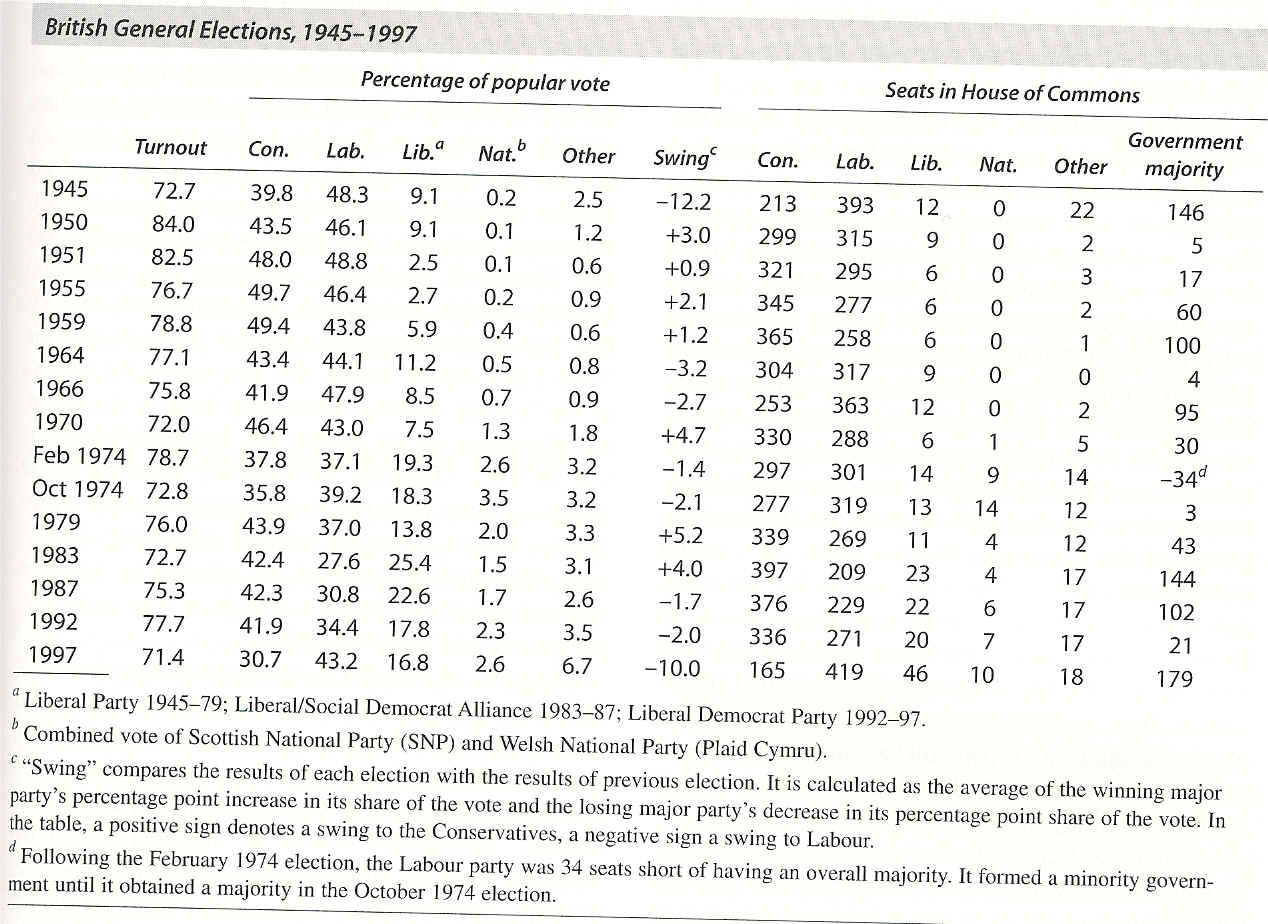
C. Operation of Parliamentary Democracy in Britain
1. PM is leader of majority party
2. Draws Cabinet from his/her party
3. Must have approval of Parliament for all legislation, including all financial
bills (budgets, taxes)
a. vote of no confidence - rarely invoked
b. PM can threaten to call new elections
c. Party discipline usually keeps majority party in control
d. Backbenchers rebellion - rare but possible on controversial issues like EU
4. Subject to criticism and questioning within Parliament
a. question time - either PM or Ministers answer written questions plus exchange
comments
5. Subject to review of proposed legislation within Parliamentary committees -
both standing and select but more limited than in US
6. Parliament plays little role in development of legislation - only oversight,
consent
Seating Arrangement within the House of Commons
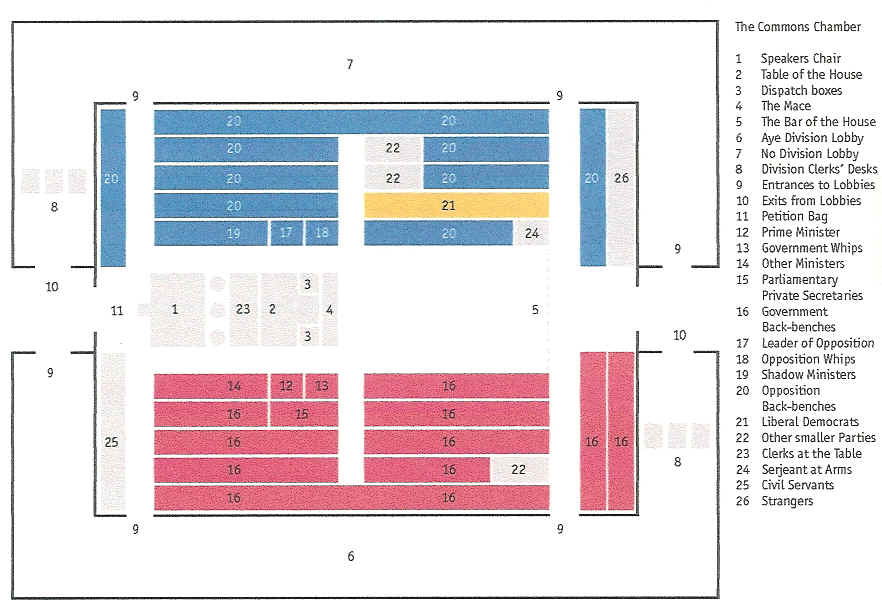
D. Cabinet government - collective responsibility for govt. policies
1. Composed of members of Commons and Lords with same political party - chosen
by PM
2. Bound together by "collective responsibility;" each Dept head
faces "individual responsibility" for running Dept.
3. Cabinet offers a check on PM - but Blair has tended to concentrate authority
outside of full Cabinet
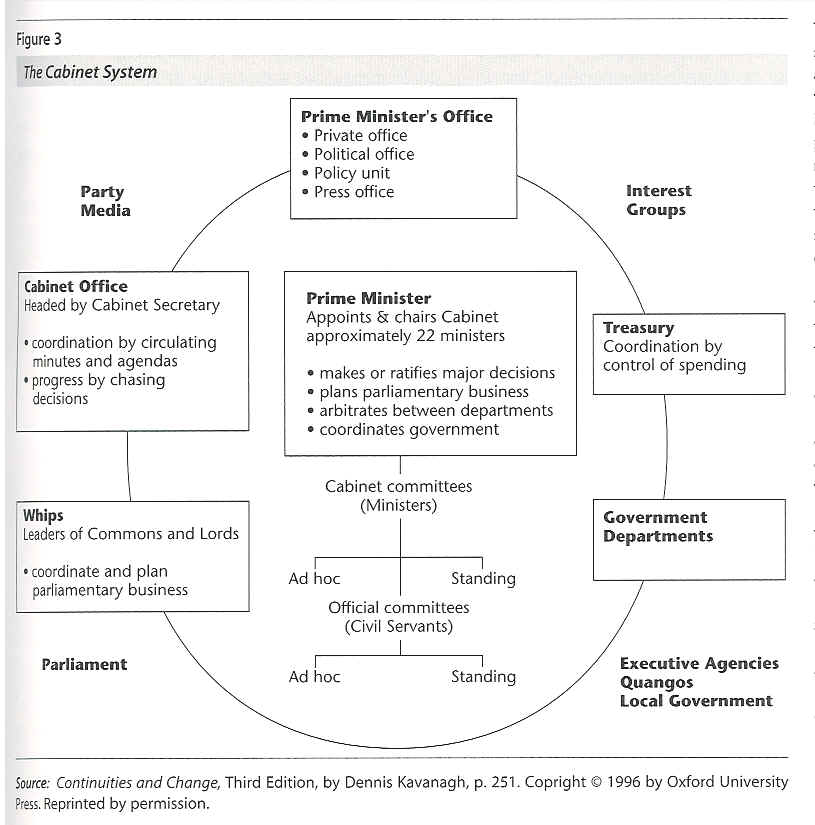
Positions with Blair's Cabinet:

Example of Members of Blair's Government beyond the Cabinet Level

Interaction between Cabinet and Civil Service

VII. Civil Service
a. Meant to provide support to Governments of all partisan stripes - impartial, permanent, anonymous, incorruptible
1. Led by a "permanent
secretary" who are assisted by deputy secretaries and undersecretaries
a. oversee
daily operations
b. help
develop legislation
1. A part of "policy communities" of interest groups, ministers and
leading civil servants
c. inform
Cabinet members of Dept. history, interests
2. Principle private secretary chosen
to help appointive political leader
b. Subject to recent downscaling and cultural change
- more outsiders now lead agencies (new public management or "NPM")
c. Other semi-public agencies - nationalized
industries, QUANGOS (quasi-nongovernmental organizations)
VIII. Judiciary
a. Differs from US - no judicial review; Courts can
only determine whether policy directives or administrative acts violate common
law or an act of Parliament
b. Less important, influential than in US
c. House of Lords - the final court of appeal on
points of law for the whole of the United Kingdom in civil cases; and for England, Wales and Northern
Ireland in criminal cases
IX. Unitary regime -
a. Sub-central political units have no special "reserved rights" - Blair reforms devolve powers to regional assemblies
a. Local government - had a history of fiscal discretion and local responsibility for some social services
1. Progressive curtailment of local government taxing authority - e.g., Thatcher's tax cap...